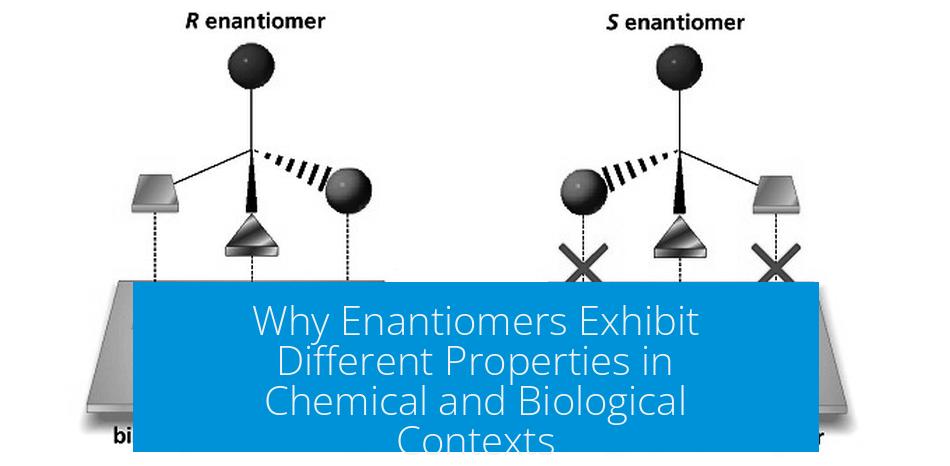Why Do Enantiomers Have Different Properties?

Enantiomers exhibit identical physical and chemical properties in most contexts but differ significantly when they interact with other chiral entities, resulting in unique biological and chemical responses.
Identical Properties Except in Chiral Interactions
Enantiomers are stereoisomers that are non-superimposable mirror images. They share the same melting points, boiling points, densities, and solubilities in achiral solvents. This means that if measured with standard techniques under achiral conditions, they appear indistinguishable.
The only situations where enantiomers exhibit different properties arise from interactions with chiral substances. Such differences do not manifest in neutral environments or achiral settings.
Mechanical Analogy of Enantiomer Behavior
A useful analogy compares enantiomers to human hands and their ability to hold objects. A pencil fits equally well in both the left and right hand, analogous to an achiral reagent interacting identically with either enantiomer. This symmetry ensures no difference in reaction or binding.
However, when a chiral entity is introduced, such as a glove, the fit becomes selective. A left-handed glove does not conform to the right hand, only to the left, illustrating how enantiomers interact differently with chiral partners.
The Role of Chirality in Biological Systems
Biological molecules often display chirality, critically influencing their interactions. Amino acids, the building blocks of proteins, exist almost exclusively in the left-handed (L-) form. As a result, enzymes and substrates display high stereochemical specificity.
Proteins are chiral entities and bind only to substrates matching their chirality. For example, only one enantiomer of many drugs binds effectively to a receptor site, analogous to a lock-and-key mechanism. This specificity determines the drug’s efficacy and safety profile.
- Only one enantiomer may be biologically active.
- The opposite enantiomer can be inactive or cause adverse effects.
- Enzymatic reactions typically favor one enantiomer.
Chiral Reagents and Selective Precipitation
Outside biological contexts, chiral molecules can be separated or purified using selective techniques that exploit chirality. For instance, a racemic mixture (equal amounts of both enantiomers) can be treated with a chiral reagent such as a chiral anion.
One enantiomer may preferentially form a precipitate with the chiral reagent while the other remains in solution, enabling selective separation. This phenomenon is not observed with achiral reagents, which interact equally with both enantiomers.
| Reagent Type | Effect on Enantiomer Mixture |
|---|---|
| Achiral Reagent | Equal precipitation of both enantiomers |
| Chiral Reagent | Selective precipitation of one enantiomer |
Chiral Analytical Techniques Reveal Differences
Enantiomers’ differences become apparent under chiral analytical methods. Techniques such as circular dichroism spectroscopy, nuclear magnetic resonance (NMR) with chiral solvents, and chromatography using chiral stationary phases can distinguish enantiomers.
Circularly polarized light, for instance, interacts differently with each enantiomer causing distinct optical rotations measurable by polarimetry. These specialized methods exploit chirality to differentiate enantiomers otherwise indistinguishable by conventional means.
Formation of Diastereomers Through Chiral Interactions
When enantiomers interact with other chiral molecules, they can form diastereomers—stereoisomers that are not mirror images and have different physical and chemical properties.
For example, reaction of a racemic mixture with a chiral reagent can create a pair of diastereomers. Unlike enantiomers, diastereomers possess different melting points, solubilities, and reactivities, offering routes to separate enantiomers selectively.
This transformation explains why some chiral interactions yield differential biological or chemical responses. The distinct properties arise from the stereochemistry of the newly formed diastereomers.
Historical and Sensory Examples of Enantiomer Differences
Historical observations demonstrate enantiomers’ distinct biological effects. In 1886, Arnaldo Piutti isolated two enantiomers of asparagine, finding that the dextrorotatory form tasted sweet while the levorotatory form was almost tasteless.
This marked the first clear evidence of enantiomers having differing sensory properties due to their interaction with chiral taste receptors. Similarly, the enantiomers of carvone smell differently—one smells like spearmint, the other like caraway. These variations arise from enantioselective binding to olfactory receptors.
Structural Specificity in Molecular Recognition
The root cause of different enantiomer properties lies in the structural specificity of molecular interactions. Like screws with clockwise and counterclockwise threads, two enantiomers fit differently into chiral environments.
This specificity governs molecular recognition, dictating binding, catalysis, and biological effects. The “hand-in-glove” analogy encapsulates this concept: a right-hand molecule fits only into a right-hand receptor, not into a left-hand counterpart.
Summary of Key Points
- Enantiomers share identical physical and chemical properties except during interactions with chiral reagents.
- Chiral interactions produce different biological and chemical effects, explaining the significance of stereochemistry in chemistry and biology.
- Mechanical analogies illustrate that only chiral partners can discriminate between enantiomers.
- Biological systems exhibit high stereospecificity; enzymes and receptors typically recognize only one enantiomer.
- Chiral reagents enable selective precipitation and separation of enantiomers.
- Chiral analytical techniques can detect enantiomeric differences by exploiting molecular chirality.
- Enantiomer and chiral reagent interactions can form diastereomers with distinct properties.
- Historical and sensory examples highlight practical differences, such as taste and smell variations.
- Structural stereospecificity underpins molecular recognition in chemical and biological settings.
Why do enantiomers have different properties only when interacting with chiral substances?
Enantiomers share identical physical and chemical properties except when they encounter chiral reagents. In such cases, their interactions differ because chiral molecules distinguish between left- and right-handed forms.
How does the concept of diastereomers explain the difference between enantiomers?
When enantiomers interact with another chiral molecule, they form diastereomers—molecules that are not mirror images. These diastereomers have distinct physical and biological properties, leading to different responses.
Why do enantiomers have different effects in biological systems?
Biological receptors are chiral and have high specificity. Only one enantiomer fits properly in the receptor’s binding site, much like a key fits a specific lock. This causes enantiomers to elicit different biological responses.
Can enantiomers show different sensory properties like taste or smell?
Yes. For instance, the two enantiomers of carvone smell different, and enantiomers of asparagine taste different. This happens due to how each enantiomer interacts uniquely with taste or smell receptors in the body.
How are enantiomers separated or identified if their properties are mostly identical?
They can be distinguished using chiral analytical techniques, such as circularly polarized light or chromatography with chiral stationary phases. Also, selective precipitation with chiral reagents can separate them based on subtle interaction differences.




Leave a Comment